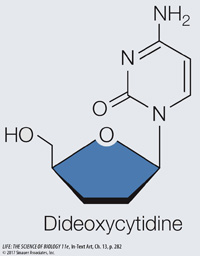recap
13.3 recap
Meselson and Stahl showed that DNA replication is semiconservative: each parent DNA strand serves as a template for a new strand. A complex of proteins, most notably DNA polymerase, is involved in replication. New DNA is polymerized in one direction only, and since the two strands are antiparallel, one strand is made continuously and the other is synthesized in short Okazaki fragments that are eventually joined.
learning outcomes
You should be able to:
Explain why the Meselson–
Stahl experiment provided evidence in support of only one model of DNA replication. Identify the function of each component needed for DNA replication.
Explain the roles of DNA helicases and single-
stranded binding proteins. Explain the need for telomerases as a consequence of the semiconservative replication of DNA.
1.
How did the Meselson–
The bacteria were prelabeled with both strands of DNA with heavy 15N. After one round of replication in light 14N, three models for DNA replication had different predictions:
Conservative: There would be original DNA (all heavy) and new DNA (all light) in equal amounts. This did not occur.
Dispersive: There would be light, heavy, and intermediate DNA in no fixed proportions. This did not occur.
Semiconservative: There would be only intermediate DNA, with one light and one heavy strand. This did occur.
2.
Name five proteins needed for DNA replication. What are their roles?
The five proteins involved in DNA replication are DNA helicase (unwinds the double helix), single-
3.
Why are there special sequences at the ends of chromosomes, and how are they replicated?
The special sequences at the ends of chromosomes are called telomeres, and they can be replicated if necessary. After DNA replication, the primer regions at the 3′ ends of the long DNA in chromosomes are removed. This shortens the DNA and makes it unstable. In some cells, such as gamete-
4.
The drug dideoxycytidine, used to treat certain viral infections, is a nucleotide made with 2′,3′-dideoxyribose. This sugar lacks —OH groups at both the 2′ and the 3′ positions. Explain why this drug stops the growth of a DNA chain when added to DNA.

DNA replication adds new nucleotides to the 3′ end of DNA, where there is an —OH group on the sugar at the 3′ position. If there is no —OH group, there cannot be a condensation reaction and formation of a bond to the next nucleotide, so replication stops.
The complex process of DNA replication is amazingly accurate, but it is not perfect. What happens when things go wrong?